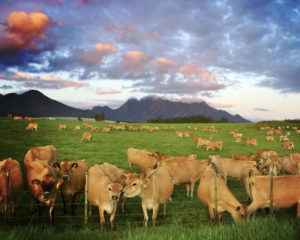BOVINE HERD PATHOGENIC VACCINES

MELACH BOVINE HERD PATHOGENIC VACCINES
Herd pathogenic vaccines are specifically formulated to strategically control an existing infectious condition as a preventative tool in a particular herd where the pathogens were collected during an existing disease condition.
Existing pathogen strains, responsible for a particular infectious condition or one that is a threat to the susceptible herd, are isolated, scientifically formulated and processed into a safe and effective vaccine.
Standard registered commercial vaccines generally available in industry, that do not provide sufficient immune cover against local strains to protect a herd against the threat of a particular contagious disease, are supplemented by such a unique product to the benefit of the particular threatened herd.

It therefore has a completely different function to and is supplementary to known commercially manufactured vaccines for a general disease prevention program.
Some pathogens have the ability to evolve as well as hedge themselves in terms of pathogenicity and immunological traceability.
Certain diseases are caused by a variety of serotypes and worldwide no commercially available vaccine is able to provide protection against all strains and serotypes that occur in local areas, as well as small outbreaks of diseases.
Interaction between pathogens as well as their survivability against disinfectants, antibiotics, herd management as well as environmental circumstances, all play a role in determining which organism survives to cause disease.
Discerning veterinary diagnostics, reliable vaccine preparation technology and a safe as well as sterile end product are all pre-requisites for a good, effective bovine herd pathogenic vaccine. This serves as a preventative measure causing a speedy reaction time resulting in a healthy herd as well as prosperity.
A good example of herd pathogenic vaccine being used successfully is a well-planned and managed mastitis scheme as one of the preventative measures to a lower somatic cell count.
Numerous different pathogens can cause mastitis, but it is well documented that in certain stables, with their unique management and treatment procedures, only certain pathogens survive and cause mastitis during a particular period of exposure.
Intensification and other epidemic environmental conditions cause certain pathogens to survive and threaten a herd. Examples of this are known to every calf raising unit where sore eyes, diarrhea, pneumonia, and warts are prevalent.
Feedlot enterprises are particularly interested in preventative measures because foreign pathogens come from all over as animals are added to the feedlot. This exposes susceptible animals in the feedlot. The nature and function of a herd pathogenic vaccine is such that it is a veterinarian prescription product, not registered, that serves as an emergency measure either because no registered product exists, or because the threat arose because of the relevant herd’s unique circumstances or need. For this reason herd pathogenic vaccines always have to be regarded as of an experimental nature, and have to be applied strictly according to the veterinarian’s prescription.
A clear strategic vaccination protocol has to be followed in conjunction with and supported by an approved preventative health program. An effectiveness control action plan also has to be in place.
A herd pathogenic vaccine is based on thorough diagnosis, identification and cultivation of the relevant organisms, manufactured and recommended by a veterinarian for a specific time and herd.
The owner of the relevant herd voluntarily accepts the risk and administration of the vaccine out of free will, because there is no alternative treatment available for the threat to the herd.
Normal vaccine handling preventative measures have to be maintained constantly, i.e.:
- In the case of any side effects or weak reaction after administration of the vaccine, the veterinarian responsible for the vaccine prescription should be notified immediately.
- Keep the vaccine out of the reach of children and uninformed persons.
- Keep refrigerated between 4-10 degrees Celsius.
- Protect against direct sunlight.
- Use sterilized needles and injections.
- Avoid chemical sterilization which can influence effectiveness.
- Do not use in conjunction with other medication or vaccines.
- Destroy by fire all containers, unused vaccines as well as needles and injections.